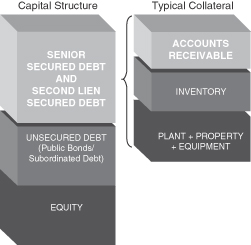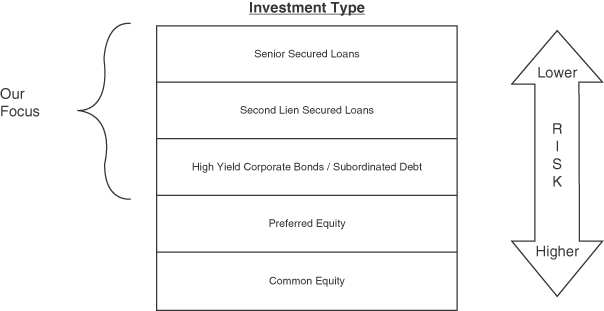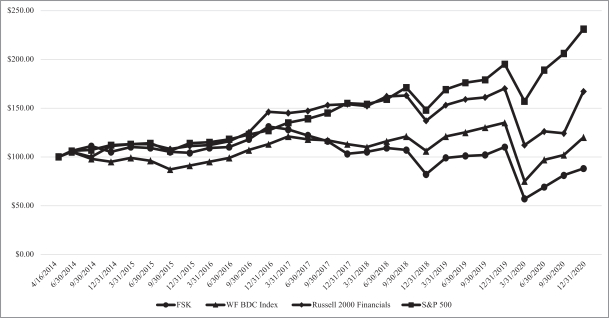required administrative services, which includes being responsible for the financial records that we are required to maintain and preparing reports for our stockholders and reports filed with the SEC. In addition, FB Advisor assists us in calculating our net asset value, overseeing the preparation and filing of tax returns and the printing and dissemination of reports to our stockholders, and generally overseeing the payment of our expenses and the performance of administrative and professional services rendered to us by others.
Pursuant to our administration agreement, dated April 16, 2014, or the administration agreement, we reimburse FB Advisor for expenses necessary to perform services related to our administration and operations, including FB Advisor’s allocable portion of the compensation and related expenses of certain personnel of FS Investments providing administrative services to us on behalf of FB Advisor. We reimburse FB Advisor no less than quarterly for all costs and expenses incurred by FB Advisor in performing its obligations and providing personnel and facilities under the administration agreement. FB Advisor allocates the cost of such services to us based on factors such as total assets, revenues, time allocations and/or other reasonable metrics. Our board of directors reviews the methodology employed in determining how the expenses are allocated to us and the proposed allocation of administrative expenses among us and certain affiliates of FB Advisor. Our board of directors then assesses the reasonableness of such reimbursements for expenses allocated to us based on the breadth, depth and quality of such services as compared to the estimated cost to us of obtaining similar services from third-party service providers known to be available. In addition, our board of directors considers whether any single third-party service provider would be capable of providing all such services at comparable cost and quality. Finally, our board of directors compares the total amount paid to FB Advisor for such services as a percentage of our net assets to the same ratio as reported by other comparable BDCs.
We have contracted with State Street Bank and Trust Company to provide various accounting and administrative services, including, but not limited to, preparing preliminary financial information for review by FB Advisor, preparing and monitoring expense budgets, maintaining accounting and corporate books and records, processing trade information provided by us and performing testing with respect to RIC compliance. Prior to April 1, 2015, we had contracted with Vigilant Compliance, LLC to provide the services of Salvatore Faia as our chief compliance officer.
As a BDC, we are required to comply with certain regulatory requirements. Also, while we are permitted to finance investments using debt, our ability to use debt will be limited in certain significant respects pursuant to the 1940 Act. Within the limits of existing regulation, we will adjust our use of debt, according to market conditions, to the level we believe will allow us to generate maximum risk-adjusted returns. See “—Regulation.” We have elected to be treated for U.S. federal income tax purposes, and intend to qualify annually, as a RIC under Subchapter M of the Code.
Investment Types
Our portfolio is comprised primarily of investments in senior secured loans and second lien secured loans of private middle market U.S. companies and, to a lesser extent, subordinated loans of private U.S. companies. Although we do not expect a significant portion of our portfolio to be comprised of subordinated loans, there is no limit on the amount of such loans in which we may invest. We may purchase interests in loans or make other debt investments, including investments in senior secured bonds, through secondary market transactions in the“over-the- counter” market or directly from our target companies as primary market or directly originated investments. In connection with our debt investments, we may on occasion receive equity interests such as warrants or options as additional consideration. We may also purchase or otherwise acquire minority interests in the form of common or preferred equity or equity-related securities, such as rights and warrants that may be converted into or exchanged for common stock or other equity or the cash value of common stock or other equity, in our target companies, generally obtained in conjunction with one of our debt investments or through aco-investment with a financial sponsor, such as an institutional investor or private equity firm. In the future, we may achieve liquidity through a merger or acquisition of a portfolio company, a public offering of a portfolio company’s stock or by exercising our right, if any, to require a portfolio company to repurchase the equity-related securities we hold.
Convertible Securities
We may invest in convertible securities, such as bonds, debentures, notes, preferred stocks or other securities that may be converted into, or exchanged for, a specified amount of common stock of the same or different issuer within a particular period of time at a specified price or formula.
Non-U.S. Securities
We may invest in non-U.S. securities, which may include securities denominated in U.S. dollars or in non-U.S. currencies and securities of companies in emerging markets, to the extent permitted by the 1940 Act.
Investments in Asset-Based Opportunities
We may invest in asset-based opportunities through joint ventures, investment platforms, private investment funds or other business entities that provide one or more of the following services: origination or sourcing of potential investment opportunities, due diligence and negotiation of potential investment opportunities and/or servicing, development and management (including turnaround) and disposition of investments. Such investments may be in or alongside existing or newly formed operators, consultants and/or managers that pursue such opportunities and may or may not include capital and/or assets contributed by third party investors. Such investments may include opportunities to direct-finance physical assets, such as airplanes and ships, and/or operating assets, such as financial service entities, as opposed to investment securities, or to invest in origination and/or servicing platforms directly. These asset-based opportunities are expected to offer mezzanine-like structural downside protection as well as asset collateral, and equity-like upside that can be achieved through appreciation at the asset-level or, in the case of platforms, through growth of the enterprise value. Key areas of focus include, without limitation, aircraft, real estate and consumer finance.
Structured Products
We may invest in structured products, which may include collateralized debt obligations, collateralized bond obligations, collateralized loan obligations, structured notes and credit-linked notes. The issuers of such investment products may be structured as trusts or other types of pooled investment vehicles. Such products may also involve the deposit with or purchase by an entity of the underlying investments and the issuance by that entity of one or more classes of securities backed by, or representing interests in, the underlying investments or referencing an indicator related to such investments.
Derivatives
We may also invest from time to time in derivatives, including total return swaps, interest rate swaps, credit default swaps and foreign currency forward contracts. We anticipate that any use of derivatives would primarily be as a substitute for investing in conventional securities or to hedge potential risk that is identified by the Advisor.
Investments with Third-Parties
We may co-invest with third parties through partnerships, joint ventures or other entities, thereby acquiring jointly-controlled or non-controlling interests in certain investments in conjunction with participation by one or more third parties in such investment. Such joint venture partners or third party managers may include former personnel of the Advisor or its affiliates or associated persons.
Cash and Cash Equivalents
We may maintain a certain level of cash or equivalent instruments, including money market funds, to make follow-on investments, if necessary, in existing portfolio companies or to take advantage of new opportunities.
Comparison of Targeted Debt Investments to Corporate Bonds
Loans to private companies are debt instruments that can be compared to corporate bonds to aid an investor’s understanding. As with corporate bonds, loans to private companies can range in credit quality depending on security-specific





